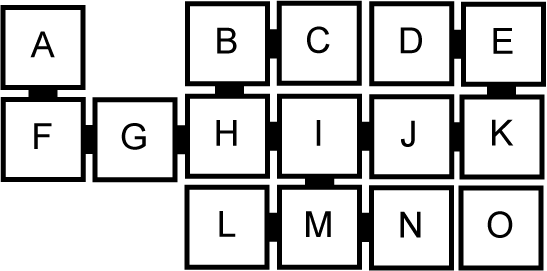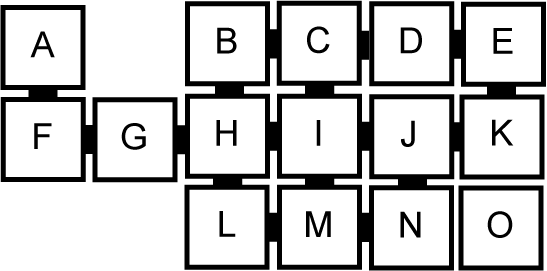
Create a class named "MazeSolver" that finds a path from a start room to a destination within a maze using recursion. Each room can have a maximum of four doors, one north, one east, one south, and one west. However, a room may have less than four doors, or none at all.
The API for the MazeRoom class is available here. The class has already been provided as part of the 1030.jar file. Download it here and remember its location. In Eclipse, add the jar to your build path (goto Project > Properties > Java Build Path > Libraries > Add External JARs...). Navigate to the location of the jar, select it, and click "Open".
Use the following code to create a class named "MazeSolver":
import java.io.PrintStream;
import java.util.Scanner;
/**
* Given a MazeRoom and a room name, the search facility of this class
* will return a path to the desired room, if one exists.
*/
public class MazeSolver
{
private MazeRoom start;
/**
* Initializes this object.
*/
public MazeSolver()
{
start = MazeRoom.buildMaze();
}
/**
* Provides access to the maze entrance.
* @return the entrance to the maze.
*/
public MazeRoom getEntrance()
{
return start;
}
/**
* Finds a path from the current room in the maze to the room with the name
* provided by goal, if one exists.
* @param current the current room being searched.
* @param from the room (just searched) through which this room was entered.
* @param goal the name of the destination room.
* @return a path from the current room to the goal (e.g., "A->F->G"), or
* null if no path exists.
*/
public String findPath(MazeRoom current, MazeRoom from, String goal)
{
// Your code goes here...
// Hint: When you enter a room (i.e., current) search each connected,
// non-null room (using goNorth(), goSouth(), goEast(), and goWest()),
// except the one from which you just came (i.e., from). Stop when the
// current room's name is the goal.
;
}
/**
* Used to test the functionality of this class.
*/
public static void main(String[] args)
{
PrintStream out = System.out;
Scanner in = new Scanner(System.in);
MazeSolver ms = new MazeSolver();
MazeRoom start = ms.getEntrance();
out.println("The entrance to the maze is room " + start.getName());
out.print("Enter the destination room name: ");
String goal = in.next();
String path = ms.findPath(start, null, goal);
out.print("The path from " + start.getName() + " to " + goal + " is ");
out.println(path == null ? "non existent!" : (path + "."));
}
}
Implement the findPath method and use this code to test your class. Ensure that you know what this code does and how it works.
Note that line 17 calls MazeRoom.buildMaze(). This returns a reference to "A" in the maze illustrated here:

Take your solution tothe exercise above and change line 17 to read start = MazeRoom.buildCyclicMaze();. This generates the maze illustrated below. Run your solution and try to find a path from "I" to "L" or "N" or "B". What happens?

The cycles (i.e., loops) in the maze can cause infinite recursive calls. To solve this issue, we can use a set to keep track of the rooms we have already visited. If a room is already in the set, we have already been there, so you do not need to search it (again).
Use the following code to create a class named "MazeSolver2":
import java.io.PrintStream;
import java.util.HashSet;
import java.util.Scanner;
/**
* Given a MazeRoom and a room name, the search facility of this class
* will return a path to the desired room, if one exists.
*
* The search will succeed, even if the maze contains cycles (i.e., loops).
*/
public class MazeSolver2
{
private MazeRoom start;
/**
* Initializes this object.
*/
public MazeSolver2()
{
start = MazeRoom.buildCyclicMaze();
}
/**
* Provides access to the maze entrance.
* @return the entrance to the maze.
*/
public MazeRoom getEntrance()
{
return start;
}
/**
* Finds a path from the current room in the maze to the room with the name
* provided by goal, if one exists.
* @param current the current room being searched.
* @param goal the name of the destination room.
* @param visited all the rooms already searched.
* @return a path from the current room to the goal (e.g., "A->F->G"), or
* null if no path exists.
*/
public String findPath(MazeRoom current, String goal,
HashSet<MazeRoom> visited)
{
// Your code goes here...
// Hint: When you enter a room (i.e., current) search each connected,
// non-null room (using goNorth(), goSouth(), goEast(), and goWest()),
// except ones that are already in the set. Stop when the current room's
// name is the goal.
;
}
/**
* Used to test the functionality of this class.
*/
public static void main(String[] args)
{
PrintStream out = System.out;
Scanner in = new Scanner(System.in);
MazeSolver2 ms = new MazeSolver2();
MazeRoom start = ms.getEntrance();
out.println("The entrance to the maze is room " + start.getName());
out.print("Enter the destination room name: ");
String goal = in.next();
String path = ms.findPath(start, goal, new HashSet<MazeRoom>());
out.print("\nThe path from " + start.getName() + " to " + goal + " is ");
out.println(path == null ? "non existent!" : (path + "."));
}
}
Implement the findPath method and use this code to test your class. Ensure that you know what this code does and how it works.